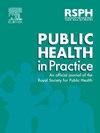Age of first digital device use and screen media use at age 15: A cross-sectional analysis of 384,591 participants from 55 countries
IF 1.9
Q2 PUBLIC, ENVIRONMENTAL & OCCUPATIONAL HEALTH
引用次数: 0
Abstract
Objectives
We investigated the associations between age of first digital device use and screen media use at age 15.
Study design and methods
Utilizing cross-sectional data from the 2018 Program for International Student Assessment, we analyzed responses from 384,591 fifteen-year-olds (50 % girls) from 55 countries on their age of first device use and current frequency of 12 screen behaviours. Behaviors were categorized as social, gaming, recreational, educational/practical (grouped into regular [every day; almost every day] and non-regular users [once or twice a week; once or twice a month; never or hardly ever]. Generalized linear regression, adjusted for highest level of schooling of mother/father and with student sampling and replicate weights to account for the sampling design was used to estimate prevalence ratios (PR) for regular use of each screen activity per additional year of age when first using devices.
Results
Higher age of first device use was associated with lower prevalence of being a regular user for nine screen behaviours at age 15, with some sex differences. The strongest association was found for using email’ (PR per increasing year of first device use for total sample: 0.956 [95%CI 0.935; 0.977]; boys: 0.956 [95%CI 0.928; 0.986]) and playing collaborative online games (girls: 0.947 [95%CI 0.905; 0.991]). Later first use of devices was associated with decreased prevalence of regular use for social purposes at age 15.
Conclusion
The later children start using digital devices, the less likely they are to be regular users at 15 years, especially social use. Delaying children's introduction to digital devices may decrease future use.
首次使用数字设备的年龄和15岁时使用屏幕媒体的年龄:来自55个国家的384591名参与者的横断面分析
目的研究15岁儿童首次使用电子设备的年龄与屏幕媒体使用的关系。研究设计和方法利用2018年国际学生评估项目的横截面数据,我们分析了来自55个国家的384591名15岁学生(50%是女孩)首次使用电子设备的年龄和目前使用12种屏幕行为的频率。行为被分类为社交、游戏、娱乐、教育/实践(分为每天;几乎每天都有)和非固定用户(每周一次或两次;一个月一次或两次;从未或几乎从未]。采用广义线性回归,根据母亲/父亲的最高受教育程度进行调整,并采用学生抽样和重复权重来解释抽样设计,以估计首次使用设备时每增加一岁定期使用每种屏幕活动的患病率比率(PR)。结果第一次使用电子设备的年龄越大,15岁时成为9种屏幕行为的常规用户的比例就越低,并存在一定的性别差异。在总样本中,使用电子邮件(每增加第一次设备使用年份的PR)的相关性最强:0.956 [95%CI 0.935;0.977);男孩:0.956 [95%CI 0.928;0.986])和玩协作网络游戏(女孩:0.947 [95%CI 0.905;0.991])。第一次使用电子设备的年龄越晚,15岁时经常用于社交目的的比例就越低。结论儿童越晚开始使用数字设备,在15岁时成为常规用户的可能性就越小,尤其是社交使用。推迟孩子接触数字设备可能会减少他们未来的使用。
本文章由计算机程序翻译,如有差异,请以英文原文为准。
求助全文
约1分钟内获得全文
求助全文

 求助内容:
求助内容: 应助结果提醒方式:
应助结果提醒方式:


